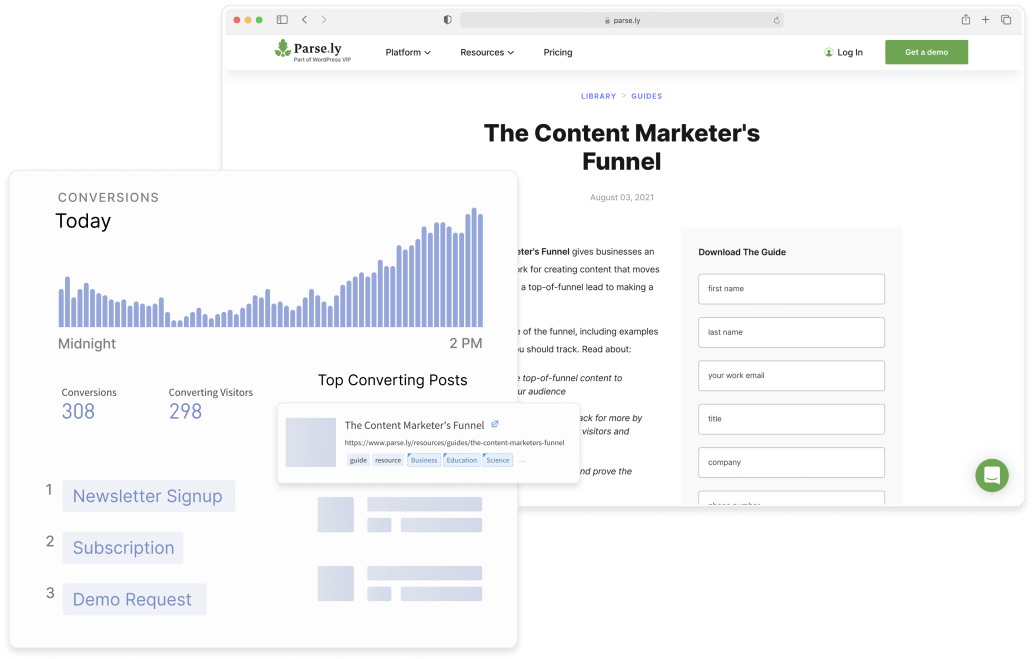What does your content creation process look like? If you’re like most content marketers, you’re presumably scrambling to brainstorm, research, write, edit, and publish all sorts of content desired by your organization, all while maintaining the quality of each piece.
With more businesses prioritizing content to drive revenue, content marketers are under pressure to churn out a lot of content at a fast pace—and for that content to lead to more growth. But when content teams are small, it can be difficult to keep up with the increasing demand. And with so many marketers flying blind without a deep understanding of content analytics, a lot of time is wasted creating content that doesn’t resonate.
So, when your company asks for more content—and faster—what should you do? To help feed the content beast at your organization and drive the greatest business outcomes, we’ve compiled five actionable strategies to incorporate into your content creation process this year.
1. Leverage content analytics to understand what works
The first step to improving your content creation process is gaining insight into which content pieces are performing the best. Without tracking content metrics, it’s difficult to pinpoint strategies that work, how people are engaging with content, and where your content is falling short.
While many marketing teams utilize measurement tools to track their content performance, many content marketers lack deeper understanding of the metrics that really matter. So-called “vanity metrics” like pageviews and email clicks offer little perspective into how your content is actually performing.
Instead, content marketers need to focus on metrics that directly link their content to broader business metrics, such as conversions, leads, or costs to acquire a customer. Content conversions are the numbers that tell the full story of how your content fits throughout a customer’s lifecycle journey. This is also how you can prove the impact of your work and get buy-in from your leadership team.

2. Use your learnings to inform content strategy
After analyzing your existing content, use your performance metrics to evaluate the content strategies that work, and re-invest in them to repeat the success. That way, you’re not just brainstorming random blog topics or throwing around ideas for potential ebooks in hopes that something sticks.
Gather input from a wide range of sources—including analytics, market research, internal SMEs, and more—to prioritize the content to create. Understand how certain pieces of content fit the needs of the customer at different stages of the buying journey and build a full-funnel content roadmap, complete with awareness content, engagement content, and decision content.
Craft your new content strategy, keeping in mind elements such as:
- Type of content: What kind of content does your target audience engage with most? Whether it’s email newsletters, ebooks, or social posts, plan on producing more of that content format.
- Topic: Your audience may be more interested in some topics over others. For instance, if your audience doesn’t seem to engage with your how-to blogs, perhaps it’s better to spend time producing blogs around topics that consistently perform well, whether it’s about current industry trends or your latest products.
- Tone and voice: Every successful brand has their own style and brand personality. It’s worth A/B testing different writing styles to see what kind of tone, voice, or messaging your target audience connects with most. For instance, shorter, punchier copy may resonate better with your audience than more elevated language.
3. Set up a content assembly line
While content marketers are typically responsible for handling the bulk of the content creation process, producing content is truly a team effort. Developing a single piece of content requires not only writers, but also marketing operations managers to pull insights, demand gen managers to execute campaigns, designers to create visual assets, and social media managers to amplify promotion.
To accelerate your content creation process and operate like a well-oiled machine, set up a repeatable, “content assembly line.” Use a task management tool to ensure that nothing is missed by stakeholders involved.
Say you’re producing a gated ebook. Before you start, create a checklist of tasks and assign responsibilities. For example:
| Task | Assignee | Due date |
|---|---|---|
| ◻︎Write outline ◻︎Provide feedback on outline | Content Writer Editor | June 1 June 3 |
| ◻︎Write first draft ◻︎Provide feedback on first draft | Content Writer Editor (+ any other stakeholders) | June 9 June 13 |
| ◻︎Write second draft ◻︎Provide feedback on second draft | Content Writer Editor (+ any other stakeholders) | June 17 June 22 |
| ◻︎Finalize copy and send to designer | Content Writer | June 24 |
| Design assets: ◻︎Ebook ◻︎Landing page image ◻︎Email banner image ◻︎Social share image ◻︎Ad creative | Designer | July 1 |
| Write promotional copy: ◻︎Landing page ◻︎Social ◻︎Paid ads ◻︎Nurture emails | Content Writer | July 1 |
| Set up campaign: ◻︎Landing page and download form ◻︎Email program | Marketing Ops Manager | July 1 |
| Launch: ◻︎Social ◻︎Paid ads ◻︎Internal network | Marketing Ops Manager Social Media Manager Demand Gen Manager Content Writer | July 5 |
This will keep everyone aligned, giving them transparency into the content process and helping make sure content gets published in a timely manner.

4. Keep a content calendar
Nearly eight in 10 content marketers say they want to create more content—but that doesn’t mean it’s easy to come up with new content ideas. To avoid getting stuck in a content rut, set up a content calendar and outline new topics at least a month in advance of publishing. This will accelerate your content creation plan, letting you spend less time brainstorming and more time actually writing.
Perhaps more importantly, your content calendar will serve as a home for your new, data-backed content strategy—and hold you accountable to plan only content initiatives that drive growth. You’ll also have a bird’s-eye view over all content being published throughout the month and be able to pace it out at a suitable cadence.
When creating your content calendar, mark each piece of content with:
- Topic
- Keyword
- Publishing date
- Format of content
- Category
- Any relevant notes
5. Repurpose content to save time and resources
Creating fresh content is great—but if you’re trying to save time and resources, repurposing content is a quick, cost-effective way to scale content creation. By repurposing content, you can amplify the footprint of your website, capitalize on past learnings, and most importantly, maximize your content team’s efforts rather than starting from ground up with every piece.
Reimagine how an existing piece of content can take new forms across other relevant marketing channels, e.g., blog, email newsletter, paid ads, or organic social media. Even better, kick things up a notch by leveraging the expertise of your colleagues, whose fresh insights can rejuvenate older content into something entirely new.
For example, you might combine interesting takeaways from a well-attended webinar with new insights from an in-house expert, then transform the original content into a new Q&A-style blog.
Bonus: This approach allows you to support every stage of the marketing funnel with engaging content without spending more budget. For more tips on repurposing content, check out this guide.
Fuel your content creation process
Today, everyone wants to create more content—and faster.
If you’re looking to speed up your content creation process while producing high-quality content that drives business growth, start by analyzing your content analytics. Deep dive into how your content fits throughout a customer’s lifecycle journey, and develop a content roadmap around the most successful strategies. Support your content strategy by building an efficient assembly line, maintaining a content calendar, and repurposing existing content.
To learn more about how content teams are driving growth, measuring success, and thinking about the future of content marketing, read our Content Matters 2022 Report.



